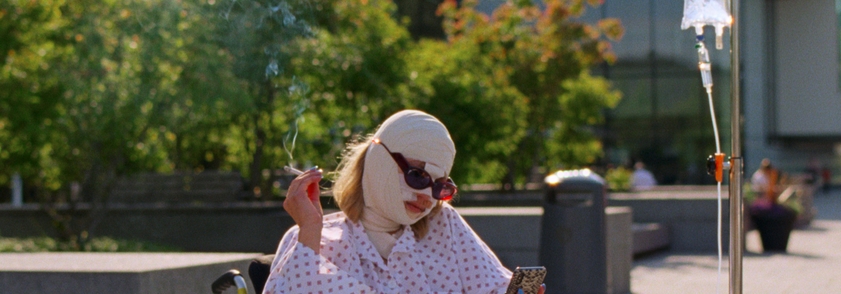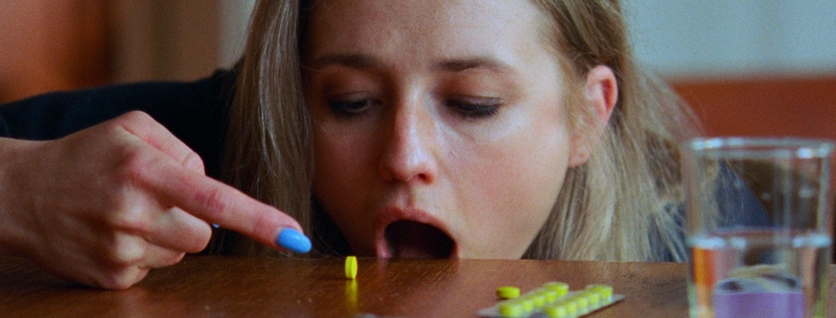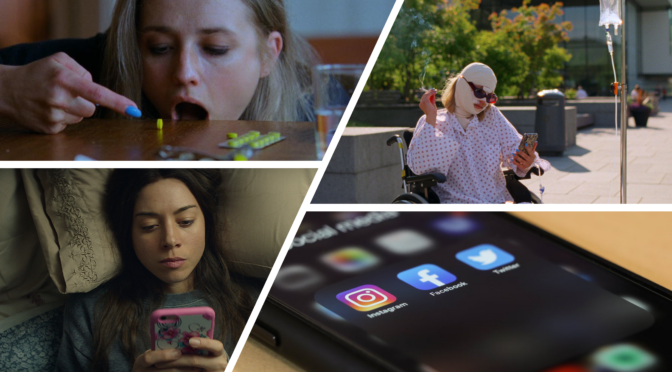SICK OF MYSELF is not for the faint-hearted. Released in the UK this year, Kristoffer Borgli’s first feature is a hilariously gruesome body horror. It’s also the best satire of the year.
The film opens with a young woman frantically jealous of her artist boyfriend’s newfound fame. His party trick is stealing expensive furniture, turning it upside down and exhibiting it as art. In a shock-hungry media world, he is feted by galleries and friends alike. The more Thomas (Eirik Sæther) shines, the more Signe (Kristine Kujath Thorp) resents him. Her craving for attention gets so bad that she procures an illegal Russian drug, ‘Lidexol’, which causes a terrible skin affliction, and takes enough of it that she ends up in hospital, her face bubbled and scarred. We watch in horror as this once merely dissatisfied girl morphs into a narcissistic monster, posturing endlessly, spawning interviews and woke modelling campaigns with insatiable thirst, as her body disintegrates around her. It’s a wackily eccentric ride, but, as Bret Easton Ellis put it, it’s also “one of the first films to really sum up the hideous moment we live in and what it has done to people”.
SICK OF MYSELF illustrates how social media has warped how we see the world. Signe’s brain translates everything into a tool for self-promotion. Bandaged to the eyelids, she excitedly posts selfies, apparently oblivious to the harm she’s done to herself. The more ill she gets, the more excited she is about the content she has to exploit. There’s a brilliant parody of the opening of CLOSER where Natalie Portman strides down the street, catching Jude Law’s eye with her mysterious smile. Signe, radiantly proud of her melted face, strides in slow motion too, but the man who sees her just seems mystified as to how she could look so happy.
What’s unnerving is how recognisable Signe’s thought processes are. The impulse to broadcast significant moments in her life, the thrill of the positive response and the ensuing paranoia about what people really thought are all worryingly familiar. The film’s real target is the madness of today’s social media world. It’s other people’s endorsement that allows for Signe’s narcissism to spiral out of control. Her behaviour is so normalised they hesitate to check her at all. Victim culture, where you can never suggest that anyone uses their story for the wrong reasons, means they can’t. As she pushes the envelope ever further, Signe’s world becomes a morality-free zone where the body can be sick, but as long as the ego is fed, everything is alright.
INGRID GOES WEST (2017) by Matt Spicer also brilliantly portrayed the darker sides of social media. Ingrid (Aubrey Plaza) is an emotionally unstable woman who stalks an LA influencer, Taylor (Elizabeth Olsen), so obsessively online that we realise with a jolt that she has become an actual stalker, to brilliantly comic ends. Again, the success of the film lies in how worryingly recognisable her habits are, as Ingrid manically scrolls from the darkness of her bedroom, buying whatever Taylor is wearing, visiting the places she goes, comparing herself frantically at every step and then creating her own ‘perfect’ life online to match up. We’ve all done something similar.

“The dangers of social media have spawned a slate of horror films over the last decade [but] SICK OF MYSELF breaks new ground because it’s also a fascinating portrayal of addiction, in this case to fame.”
The dangers of social media have spawned a slate of horror films over the last decade. INFLUENCER, CLICKBAIT and SPREE all tell of uncontrollable egos in the face of online success. Dramas such as NOT OKAY cover similar ground. The problem is that these cautionary tales are often one-note or hysterical without going much deeper.
SICK OF MYSELF breaks new ground because it’s also a fascinating portrayal of addiction, in this case to fame. Borgli uses dream sequences to show how Signe’s relative fame encourages her hopes for real celebrity. After coercing a journalist friend into interviewing her, her mind skips from their meeting to visions of herself on the news having gone “viral…a world sensation”. Hired for a low-budget photo shoot, she fantasises about jetting around the world as a supermodel. We see the addiction taking hold as reality and dreams start to blur. When Signe admits to the journalist that she has lied about the cause of her sickness, the journalist is merely excited, exclaiming, “Signe, this is a book. People need to hear this story from your perspective”. Signe promptly writes it to major acclaim. But we soon realise that this is a fabrication of her mind, as we cut back to her empty flat where she is very alone, very sick and very much not a best-selling author. When she actually tells the journalist what she did, the journalist is outraged, yelling: “You’ve been shameless with this thing!” We want to cheer, as the reality check is so overdue, and it’s the first time we see Signe despair. And yet, her brain knows what to do to make everything better, flipping to visions of imaginary fans singing the praises of her imaginary bestseller. Every time the terror of reality approaches, she soothes herself with fantasies of paparazzi chases and the like. The speed with which these visions confuse the viewer creates a brilliant portrait of a mind plagued by these desires. The film not only suggests we’re a society increasingly addicted to fame; it shows us why.
People wanting to be seen is nothing new. Freud argued that deep down, we’re all hysterical because we’re going to die, which is why we have to keep loudly proving we’re alive. But social media has shifted the paradigm. In effect, we have all become our own PR managers and Ephron’s famous observation that “everything’s copy” now applies to everyone. The business of photo-friendly parties and sponsored events has blurred the lines between work and socialising to an extraordinary degree. When the most effective tool online is one’s self, it doesn’t leave people with a choice other than to self-promote. What we can’t track is the degree to which this highly addictive process is rewiring our brains; how many people now consider how they dress, eat, party and work in the name of content; how many children consider what the photo will look like before they see the thing itself. SICK OF MYSELF is one of the first to properly explore those questions.

“What we can’t track is the degree to which this highly addictive process is rewiring our brains; how many people now consider how they dress, eat, party and work in the name of content; how many children consider what the photo will look like before they see the thing itself. SICK OF MYSELF is one of the first to properly explore those questions.”
Another problem with social media is that it is, in effect, broadcasting, and as one Telegraph journalist gleefully exclaimed at the cancellation of Meghan Markle’s podcast: ‘Not everyone can do it’. In trying to shortcut her way to fame, Signe’s mistake is that a skin disease is not interesting enough to warrant significant attention. We laugh when she imagines the success of her book because she never writes a single word. But again, she’s worryingly recognisable as a trope. She reminded me of the reams of wannabe influencers posing on the doorsteps of Notting Hill, not realising that identikit outfits probably aren’t going to do the trick. Or THE IDOL: The Weeknd’s expensive discovery that a series should probably be about something other than the fact you want to be in a hit show. People are so frantic to be famous they forget that it needs to be earned.
Borgli’s own Instagram was wonderfully compromised at this point in terms of promoting the film and/or himself. His answer to the problem was a parody of the Mark Kermode interview with Werner Herzog about his film GRIZZLY MAN, in which Herzog got shot by a stray rifle pellet but famously continued filming. Borgli also gets shot in his interview, but this time it’s so bad he seems to be dying, and yet he refuses to stop because he’s so keen to keep talking about himself. A cynic might call it a clever excuse for some screen time of his own, but it’s so funny you’d have to be a real stickler not to agree it’s well-earned. Like his film, it’s both ridiculous and yet scarily familiar regarding the world we live in today.

